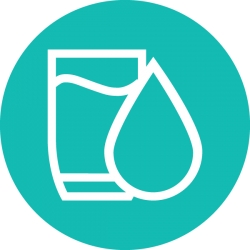Strategies for
Key Strategies
- Extend Utah’s 2025 goal of reducing per-capita water use by 25% (from 2000) to at least 35% by 2050.
- Reduce outdoor watering by meeting market demand for more houses on smaller lots, townhomes, condominiums, apartments, etc.
- Allow, encourage, and incentivize water-wise landscaping and irrigation practices.
- Significantly reduce the amount of agricultural water being converted to urban uses.
- Improve water quality and groundwater storage by improving Utah’s watersheds (e.g., by eradicating invasive species, replanting native grasses and trees, and improving grazing practices).
- Adequately maintain, and replace where needed, existing water infrastructure.
- Prepare for and develop new water supplies as needed.
This vision, created by Utahns, for Utahns, establishes a clear context, framework, and direction for policy discussions and actions to achieve the future Utahns want. Although government will play an important role, Utahns recognize that achieving the vision will also require a concerted, cooperative effort by individuals, families, businesses, and other organizations in the private sector.
Strategies
1. Significantly reduce per-capita water use in Utah communities.
- Reduce outdoor watering per household by meeting market demand and providing more houses on smaller lots, townhomes, condominiums, apartments, etc.
- Allow, encourage, and incentivize water-wise landscaping and irrigation practices.
- Consider adopting rate structures that encourage conservation (e.g., tiered rate structures) without placing undue financial burdens on individuals and businesses.
- Consider providing incentives and financial assistance to those implementing water-wise practices, such as making changes to landscaping, irrigation systems, or indoor fixtures/appliances.
- Design open spaces and government-owned landscaping to be water-wise.
- Provide resources and education on water conservation to individuals and businesses.
- Maintain and improve water infrastructure to minimize system losses.
- Understand the basin-wide effects of local conservation activities (including the effects on the environment) and plan accordingly.
2. Ensure sufficient water for agriculture to increase our food self-sufficiency.
- Sustain agriculture.
- Improve the profitability of agriculture.
- Protect high-quality agricultural lands for food production through preservation tools that are consistent with private-property rights and Utahns’ values.
- Keep agricultural water in agriculture as much as feasible.
- Implement efficiencies in agriculture that reduce actual water depletion, and, where feasible, use the conserved water to put new lands into agricultural production.
3. Adequately maintain, and replace where needed, existing water infrastructure; develop new water supplies as needed.
- Develop a plan to fund infrastructure and new water supplies through a variety of sources.
- Implement programs that allow Utahns to reuse water, including greywater (reusable washwater), especially on large landscapes, but be careful about the impacts on downstream flow.
- Increase aquifer storage and recovery where feasible.
- Consider increasing the capacity of existing reservoirs, mitigating impacts where feasible (e.g., by dedicating some portion of new storage to conservation pools and environmental flows).
- Improve watersheds so that they capture, hold, and release more water (e.g., by improving forest and rangeland management, using improved grazing techniques for livestock, increasing permeable surfaces in urban areas, and reintroducing beavers to watersheds).
- Continue to prepare for regional water development projects, while carefully evaluating timing and demand for those projects and continuing to emphasize conservation and analysis of alternatives.
- Build regional projects only in conjunction with implementing conservation and local-supply programs and only when demands reach appropriate benchmarks despite conservation.
- Preserve and protect options for developing regional projects in the future (e.g., through planning, acquiring property for right of way, and conducting design/environmental/engineering studies).
- Phase water and wastewater projects when feasible to reduce the cost to current users.
- Anticipate and preemptively meet water needs to avoid economic and social consequences of shortages.
- Put Native American water rights to use in Utah.
4. Prepare for the potential impacts of climate change.
- Diversify and increase water supply to avoid overreliance on any one source of water.
- Improve watersheds so that they capture, hold, and release more water (e.g., through improving forest and rangeland management, using improved grazing techniques for livestock, increasing permeable surfaces in urban areas, and reintroducing beavers to watersheds).
- Improve drought resilience.
- Increase research on adaptive technologies (e.g., water reuse programs) and on the effects of climate change to existing practices and infrastructure.
5. Foster a thriving economy.
- Provide assurance of a reasonable, long-term water supply.
- Maintain adequate supplies of relatively affordable water for large businesses; consider water needs when recruiting businesses.
- Ensure low-income families can maintain an affordable cost of living while still irrigating attractive yards (through water rate structures, assistance in changing landscaping and irrigation systems, or other means).
- Maintain laws and policies that promote a predictable, collaborative, and low-cost system for allocating water among competing uses.
6. Ensure water quality and quantity to adequately sustain and maintain the environment by improving watershed management and preserving natural systems.
- Develop and implement watershed management plans for both surface and groundwater.
- Implement appropriate nutrient and salinity controls.
- Increase opportunities to ensure appropriate flows in critical reaches of rivers.
- Adequately mitigate the environmental impacts of water projects.
7. Improve the availability and quality of information about Utah’s water.
- Improve the quality of water data that is collected.
- Make water data, especially real-time data, more accessible to the public.
- Improve projections of climate changes’ long-term impacts on local water.
- Improve understanding of the amount of water in and the function of water basins, including critical groundwater basins (e.g., by creating mass-balance models).


